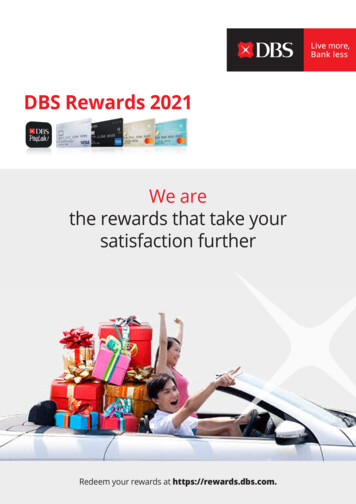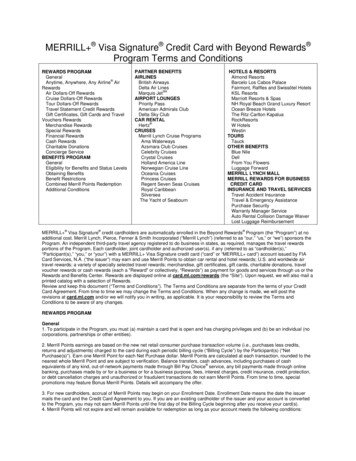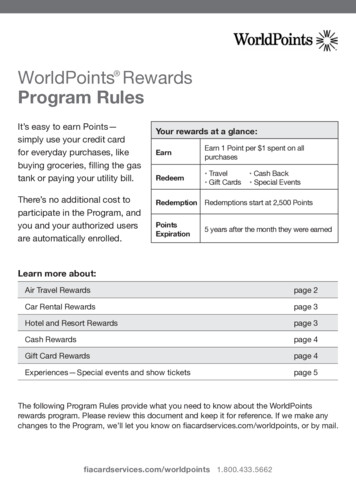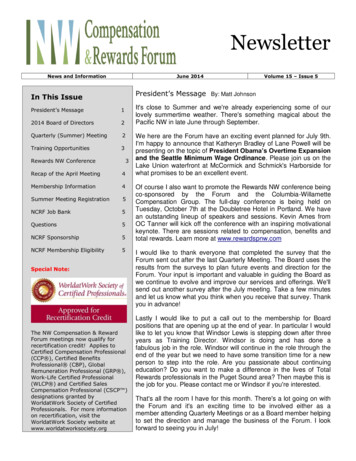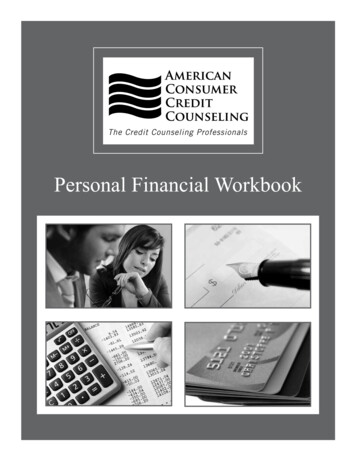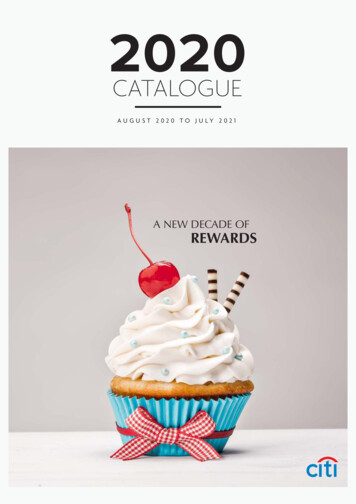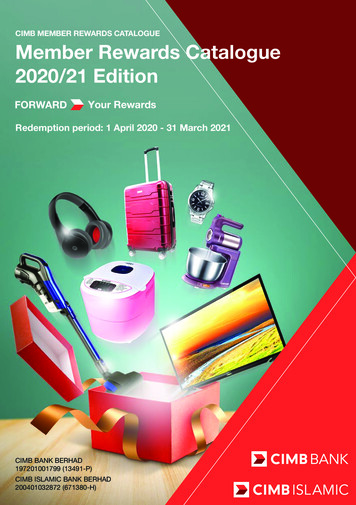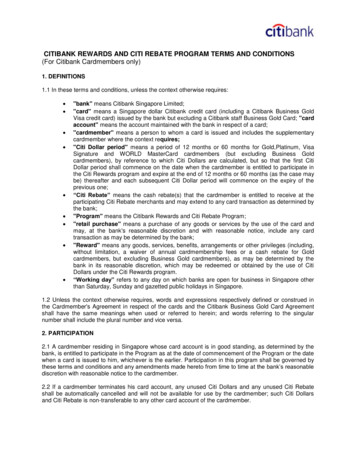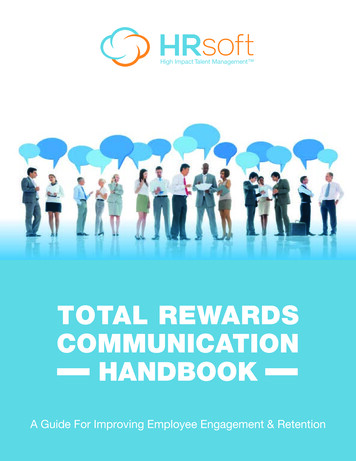
Transcription
High Impact Talent Management TOTAL REWARDSCOMMUNICATIONHANDBOOKA Guide For Improving Employee Engagement & Retention
Total Rewards Communication HandbookCopyright 2015 by Ezra Schneier and Austin MuzumdarAll rights reserved. This book or any portion thereof may not be reproduced or used in anymanner whatsoever without the express written permission of the publisher except for the useof brief quotations in a book review or scholarly journal.First Printing: April 2014ISBN 978-1-304-99567-4HRsoft, Inc.2200 Lucien Way, Suite 201Maitland, FL 32751(407) soft.comwww.HRsoft.comHRsoft, Inc. is the leading provider of High Impact Talent Management systems that includesTotal Rewards Communication software.www.HRsoft.comCopyright 2015 HRsoft, Inc. All Rights ReservedII
ContentsAcknowledgements . IVPreface . VIntroduction . 1Chapter 1: What is Total Rewards Communication? . 2Chapter 2: Considerations in Total Rewards Communication. 4Chapter 3: Setting Your Goals: The Business Case . 6Chapter 4: Choosing the Elements and Categories to Include . 7Chapter 5: Design Phase .10Chapter 6: Messaging.11Chapter 7: Assumptions, Disclaimers and Legal Review .12Chapter 8: Links to Third Party Sites and Resource List .13Chapter 9: Importing Data from the HRIS .14Chapter 10: Data Feeds, Interfaces and Computations.15Chapter 11: Testing and Using a Phase-In Approach .16Chapter 12: Promotion of Total Rewards Communication .17Chapter 13: Branding and Naming .24Chapter 14: Keep the Content Fresh & Engaging.25Chapter 15: Reporting: Monitor Traffic – Get Feedback .26Chapter 16: Walk Away Value .27Chapter 17: Total Rewards for Recruiting .29Chapter 18: What Should Not Be Included? .31Chapter 19: International Considerations .32Chapter 20: Mobility .33Chapter 21: Security and Confidentiality .34Chapter 22: Summary.35Appendix 1: Sample Total Rewards Statement .36Appendix 2: Rollout Plan .40Appendix 3: Online Total Rewards Communication Site .44About HRsoft & Authors .44www.HRsoft.comCopyright 2015 HRsoft, Inc. All Rights ReservedIII
AcknowledgementsThank you to the terrific team at HRsoft for helping with the development of this handbook andfor sharing your expertise on Total Rewards Communication.Special thanks to Ranjan Kumar, Sanjay Kohli, Tushar Ghoshal, Paula Brandi, Keith Stevenson,Shefali Goyal, Fred Nussbaum, David Kennedy and Liz Wamsteeker.And thank you to the colleagues who have generously shared their ideas and wisdom to makethis project possible. We are most grateful for your suggestions and guidance.High Impact Talent Management www.HRsoft.comCopyright 2015 HRsoft, Inc. All Rights ReservedIV
PrefaceRoutine Total Rewards (TR) Communication is appropriate for most employers.A proper Total Rewards Communication program can help employers improve business resultsby having more engaged and better informed associates.It can take the form of a simple e-mail, a more elaborate statement or an online experience.The purpose and message is consistent:You are a valued employee. We supply you with this compensation and other benefits inrecognition of all you do.Here is how our incentive and benefit programs work.We want to have an open, candid dialogue about compensation, benefits and employment.We are committed to having a strong employer/employee relationship and meet yourexpectations.We value results and believe in Pay for Performance.Many employers do not have a Total Rewards Communication strategy in place. The purposeof this handbook is to discuss how easy it can be to bring one to your organization. Bybreaking it down into discreet steps, we hope more employers will develop and implementTotal Rewards Communication.We believe there is a TR Communication plan for everyone. This should not be a one-timeevent. It should come with a clearly stated purpose and a commitment to ongoingcommunication.TR Communication shows the full value of employment. But there is much more.One last thing: It is tempting for employers to make TR Communication a self-serving messageabout the company’s generosity. That misses a much greater opportunity. The larger pictureincludes:Enhanced engagement and retention.Better alignment of individual efforts and organizational goals.Improved business results.www.HRsoft.comCopyright 2015 HRsoft, Inc. All Rights ReservedV
IntroductionSharing the full value of employment with associates supports career development, retentionand engagement - and helps employers achieve their business goals.With that in mind, the purpose of this handbook is to provide a guide to bringing total rewardscommunication to your associates.Much has been written about the importance of aligning a human capital and rewards strategywith an organization’s business strategy. Total Rewards Communication is a way to frequentlyreinforce that linkage by showing all the valuable elements associated with employment andhow they tie to organizational goals and performance. In sum, TR Communication addstransparency.Employees understand they get a salary and benefits for coming to work. But there can beuncertainty about the full value of employment. And there is often not a convenient way to findthat information in a simple, user-friendly way. Total Rewards Communication is the answer.While the specific TR information communicated and the method of sharing can vary, webelieve every employer has the ability to have some form of Total Rewards Communication.Our goal here is to help make that happen.Let’s get started.www.HRsoft.comCopyright 2015 HRsoft, Inc. All Rights Reserved1
Chapter 1: What is Total Rewards Communication?Total Rewards Communication is a way toimprove the relationship between employers andemployees.This communication shares with an associate thevalue of working for the employer during aspecific period of time in the past – and canprovide a look into the future.What’s more, TR Communication allowsemployees to more clearly understand how theirincentive program works and see the value ofretirement savings plans and health carebenefits. Employers use TR Communication asa way to engage employees. It is not just a listof financial items. Rather it is a way to expressand reinforce the company’s strategy abouttalent, compensation, pay for performance andrewards.Total Rewards information can be delivered on a statement (printed or electronic form) or witha full online experience - a personalized web site or portal. In this handbook we will look atboth delivery methods. The online method is preferred since it allows for the presentation ofcurrent data (and it is how employees want to receive information.) It also gives greaterflexibility and the ability for easier personalization. Most of what is presented here can apply toeither method of communication.The benefits of Total Rewards Communication can be summarized this way:Restates and reinforces the value of people to the success of an organization.Provides a clear message on human capital investments and their alignment with businessstrategies and goals.Challenges the notion of the competitor’s “grass is greener.”Helps dissuade entitlement if properly implemented.Provides a discussion framework for managers to value their employees.We like to think of TR Communication as the “central hub” for information about compensation,benefits and other items associated with employment. Besides aggregating the full financialvalue of employment, associates find it useful to have one convenient place to go to find thisinformation. We have all struggled with looking for log-in information for different web siteswww.HRsoft.comCopyright 2015 HRsoft, Inc. All Rights Reserved2
otal Rewards CommunicationAs we plan the Total Rewards Communication, we will always try to think about two key items:How does this reinforce our stated goals for TR Communication?What advantage does an employee receive?In our experience with planning, implementing and supporting these solutions, we see firsthandhow employees embrace Total Rewards Communication. The Return on Investment issubstantial.www.HRsoft.comCopyright 2015 HRsoft, Inc. All Rights Reserved3
Chapter 2: Considerations in Total Rewards CommunicationWe have broken down the Total Rewards Communication project into separate points toconsider. In the following chapters we will discuss each of the items which are summarizedbelow. Of course, every point is not relevant for all employers. But if you choose thoseitems that do pertain to your situation, we hope it will help organize the scope of a solutionthat meets your desires.Setting Your Goals. Clearly convey to management and associates why the Total RewardsCommunication is in place. That is, to easily and directly show the full value ofemployment, to enhance engagement and to give associates a convenient, useful resource.Establish a clear goal or set of goals for your TR Communication.Choosing the Elements to Include. In this step, the logical categories of rewards aredetermined and then the specific items within each category are selected. Compensation,Incentive Pay, Retirement Savings, Health Benefits, Continuing Education, CharitableGiving, Work-Life Benefits, etc.Design Phase. After the right data elements and categories are selected for presentation,the next step is to come up with the design and layout of the statement or web site. This ishow it will appear to associates. Employers may want to include a brief description aboutthe different elements presented. Also, determine the words used to describe the items(example: "Salary" or "Compensation," "Bonus" or "Incentive Pay.") And what values willbe shown: Current Period, Year to Date, Targets, etc. Note: all elements may not berelevant or presented to all associates. Some associates may be eligible to participate incertain programs while others are not. A profile of each associate is contained in thesystem so the proper elements are presented. If an associate is not covered by a particularbenefit or does not participate in a certain plan because of his or her job category, thatelement is not presented.Messaging. Besides descriptions of the different elements and data presented, broadermessages may be included on the statements or the online site. For example, messagingmay be included to reinforce the value placed on associates and the employer's goal ofoffering compensation and benefits to recognize talent. A letter from a manager orcompany executive may be included. Some employers feel this message is actually mosteffective when it comes from someone who is known to the associates. This may not bethe CEO. It might be a regional manager who is recognized as a leader by associates.Assumptions and Disclaimers. Some employers like to list the assumptions associatedwith values appearing on statements and certain disclaimers. Such disclaimers might statethe time periods being considered for certain elements. What’s more, they might state thatthe data is for informational purposes and other agreements or documents that are in placerelating to employment take precedent.External links. Determine what links to other sites will be included. For instance, a link maybe included to bring an associate directly to the web site of the company's 401(k) or healthbenefits plan administrator. Some employers include links to useful government sites, suchas the Social Security Administration, where associates can get helpful data. Consider thesite the "hub" of useful information relating to compensation, benefits and rewards. Youmight include a list of resources with phone numbers, e-mail addresses and web links. Thismakes the site a desired one-stop-shop for all pertinent information.www.HRsoft.comCopyright 2015 HRsoft, Inc. All Rights Reserved4
Importing Data from the HRIS. Importing data from the employer's System of Record –HRIS – is a key step when implementing an online Total Rewards Communication system.This is usually lists each employee’s demographic data and details associated with theirrole. Attention is also given to updating the data on a regular schedule. Also, compensationinformation and other data can come from the HRIS.Data Feeds and Interfaces. Data from 3rd Party Vendors. In some cases, an interfacewith a 3rd Party Vendor is used to bring data into the system following a standard filelayout. Examples of vendors include: 401(k) Plan Sponsors, Health and Welfare PlanAdministrators, Equity Award Managers, and other Benefits Providers.Testing. Make sure all of the data is presented properly and the statements or the onlinesite looks great before going live. Of course, perform Quality Assurance testing to makesure the correct data is presented for the right associates. Besides testing for dataaccuracy, examine the usability, design, navigation and all other aspects of the TRCommunication. Try it out on a small group and ask for their suggestions. Do they fullyunderstand what is presented? Identify areas of confusion and address them beforecommunicating with the full employee population.Promotion of the TR Communication Statements or Online Site. Communicate withassociates about the launch of the Total Rewards Communication and routinely remindassociates about its value. Use company newsletters, flyers posted in the office, etc.Create some buzz.Brand the site or statement. Give the statement or site a name so everyone can refer to itin the same way. Give it an identity. “Total Rewards Statement” is too bland.Keep the content fresh and engaging. Consider using different people in the organizationfor help providing content. Changing content frequently is advised. Short new messages just a few sentences - will help keep the site fresh and interesting. If you are using an onlineTR Communication, include videos and images and one or two question polls aboutrelevant subjects (and then share the results.) Calculators and modeling tools can beappealing to associates. Keep it interesting and alive.Analytics. Monitor traffic to the site to get a feel for what is working. Ask associates andmanagers for feedback. On the subject of analytics is personalizing messages with yourTotal Rewards Communication. Share messages that are relevant to associates and tiethem to the information presented.Ensure security and confidentiality.www.HRsoft.comCopyright 2015 HRsoft, Inc. All Rights Reserved5
Chapter 3: Setting Your Goals: The Business CaseState your goals, and have a plan to address those goals. This doesnot have to be elaborate. But clarify up front what you want toaccomplish with your Total Rewards Communication statements oronline site. In other words, make the business case.This clarity of purpose will help in sharing the strategic and tacticalelements in building your TR Communication. What are the number oneand number two goals you are trying to achieve? State them directlyand let those goals be widely known throughout organization. Includingmanagers from other departments in this process can build support for the TR Communication.Some employers tie TR Communication to an organization’s Employee Value Proposition, orEVP. Towers Watson, the human resource services and consulting firm, defines the EmployeeValue Proposition as: “What is offered by an employer in exchange for the productivity andperformance of an employee. It includes the entire employee “experience” from their rewardsand benefits, to the opportunity for career development and also the more intrinsic elements ofmanagement style, work environment and culture.”Simply put, “the give and the get.”According to research, organizations that do the most work developing and executing theirEmployee Value Proposition achieve superior financial performance over businesses withless-developed ones.Following are examples for TR Communication goals stated by some employers we haveworked with:Increase retentionUpgrade the relationship between employer and employeeHave employee better understand and appreciate the benefits providedLet employees know the amount of money paid by the company on their behalf for health benefitsSupport the alignment of efforts by associates with rewardsCreate awareness and get more people to participate in the 401(k) plan or other plansBuild more engagement among employeesHave associates understand more clearly how bonuses are earned and allocated:Pay-for-PerformanceIntroduce more transparency in the rewards areaReinforce a culture of engagementSupport employees throughout the employment life cycleAcknowledge contributions and recognize achievementsEnsure that employees feel valuedShow that the opportunities ahead can be valuable and rewardingwww.HRsoft.comCopyright 2015 HRsoft, Inc. All Rights Reserved6
Chapter 4: Choosing the Elements and Categoriesto IncludeWhen designing the Total Rewards Communication solution to be used for associates, acritical phase is choosing what elements or “inputs” will be included and the categories forpresenting those elements.Breaking the TR Communication into logical sections will make the presentation easier for youremployees. It will also help in organizing the design and data transfer of appropriateinformation.Consider what is important for you to emphasize. Make sure those elements are included first.(You can always add items later.)WorldatWork, a global human resources association focused on compensation, benefits,work-life and integrated total rewards, created a framework for employers to consider. YourTotal Rewards Inventory, a chart with the categories and examples of elements within eachcategory, is shown on the following page.Quality information about many aspects of Total Rewards and the framework developed byWorldatWork is available at www.worldatwork.org.The five reward categories in that framework can be used as the sections of a statement orpages used with an online Total Rewards Communication presentation. We are seeing anumber of employers use this protocol, or a variation of it, in their design and communicationof Total Rewards.www.HRsoft.comCopyright 2015 HRsoft, Inc. All Rights Reserved7
www.HRsoft.comCopyright 2015 HRsoft, Inc. All Rights Reserved8
The five categories in the standard framework are useful to build consistency and present datain an organized way:1 Compensation.2 Benefits.3 Work-Life.4 Performance and Recognition.5 Development and Career Opportunities.Compensation covers Base Pay, Premium Pay and Variable Pay. Commissions anddifferent bonuses and incentives are itemized.Benefits presents the value of the medical insurance plan and can show the employer andemployee contributions. Life insurance and other health and welfare items can also beincluded: vision, dental, prescription, disability, etc. Retirement Plans, Social SecurityInsurance, Profit Sharing and other elements can fall under this category.Work-Life covers Maternity/Paternity Leave, Adoption Leave, Health and Wellness items,Nurse Line, Health Advocacy, Dependent Care, Community and Charitable Donationprograms.Performance and Recognition can include information about awards, performance goalsand specific programs for eligible employees. Sales achievements and otherproduction-related metrics can be described here.Development and Career Opportunities. In this section, Learning, Tuition Reimbursementand Leadership Training are among the items to show. Employers can include links toavailable positions on their Career Site. Also, this section can have descriptions of otherCareer Development and Learning Information. The message is we want you to besuccessful and there are ways for you to advance your career goals and experience newand exciting things. Associates can find what is needed to be successful and what isoffered to help learn and grow each step of the way.Whether you follow the above framework or another one, it is important to give seriousconsideration to what elements will be included on your Total Rewards Communication.www.HRsoft.comCopyright 2015 HRsoft, Inc. All Rights Reserved9
Chapter 5: Design PhaseThe TR Communication Statementor online site is an opportunity toconvey important information toassociates in a user friendly andvisually appealing way. Having anexciting design is important, but itshould not overshadow thecontent or make it difficult foremployees to figure out what isbeing presented.The associate experience iscritical. Attention should begiven to making it effortless andintuitive for associates to see andunderstand the content presented.To help give associates a positive experience and a proper understanding of the contentpresented use:Clear, short descriptions of all dataPlain languageA logical flow of information.A great design can catch the attention of associates and present something new foremployees. Total Rewards Communication can have a fresh look while still following corporatedesign standards – logos, fonts, colors, and graphics.Below is a typical outline listing the sections that may be included in a TR Communication thatmay be helpful as a basic guide:What it is. Introduction – What the TR Communication is about. The goals.Why. Why the employer has generous compensation and benefits for associates.Summary of the value of the elements presented. This can be presented in a table and ina chart, such as a pie chart showing the different items.Sections for the elements and the associated financial values of items included in the TRCommunication by category: (Compensation, Benefits, Work-Life, Performance andRecognition, Development and Career Opportunities.)Modeling and Calculator features.Resource List.www.HRsoft.comCopyright 2015 HRsoft, Inc. All Rights Reserved10
Chapter 6: MessagingWhen creating a Total Rewards Communicationstatement or online solution, most of the attention is onthe numbers. That is, the dollar values associated withthe various elements and aggregating those values toshow the grand total. Yes, this is important. Yes,many associates just want to cut to the chase and seehow much money they are getting. But there is more.We see too little attention spent on the messaging thatcan be included with Total Rewards communication.These are messages that support the Total Rewardsitems. On a printed or e-mailed state-ment, themessaging can show how the employer believes in itsassociates and wants to pro-vide valuable benefits andcompetitive pay. The messaging can relate to thecompany’s pay-for-performance culture. Certainbenefits can be highlighted.Messaging can be personalized for a group of employees. For example, a message presentedto employees who are not enrolled in the company retirement plan might be about why savingfor retirement is so important and explain the 401(k) enrollment process.This is case specific for each employer, but messages about Total Rewards and why it isrel-evant to employees can support the goals established for the communication.Dear Karen,It’s an exciting time to be a member of the Progress team. We greatly value the contributionyou make to our company.We recognize that you invest in the success of Progress every day. We believe it is importantto offer you a competitive total rewards package that meets your expectations. This includes payand innovative benefits that help you and your family members - now and in the future.Thank you for helping us achieve our goals for the clients and communities we serve.Sincerely,R J. Basc President and CEOwww.HRsoft.comCopyright 2015 HRsoft, Inc. All Rights Reserved11
Chapter 7: Assumptions, Disclaimers and Legal ReviewIn the previous chapter we looked at messaging to beincluded for positive reinforcement of the Total Rewardssupplied by an employer. Sometimes, employers care toinclude certain disclaimers or assumptions on their TotalRewards statements or online system relating to thecontent.As part of the TR Communication development plan,include a step to have your attorney review the content.Too often employers ask for legal to review the site ordocument as the very last step in the roll out. Since it isnot unusual for them to have some edits, it is best tolearn about them sooner rather than later. It is easier tomake changes to the content and the design early in theprocess.Assumptions and Disclaimers may be included in therelevant section relating to the type of reward element tohelp put the values in their proper context. And there may be a statement or disclaimerincluded. Of course, the idea is not to include a lot of legal wording but help clarify what theassociate sees.A few examples are shown below to give some ideas:AssumptionsBonus compensation includes payments made for Calendar Year 2015.The cost of health and welfare benefits and insurance are for the latest period and may notreflect changes you have recently made to your coverage.Health and Welfare benefits have been calculated by annualizing premiums from thebeginning of this year.Life insurance coverage and annualized premiums are based on the (Name of InsuranceCompany) records.The Retirement Savings Account amount shown includes any applicable rollovers anddeferrals.General DisclaimersThis site does not constitute a contract of employment or a guarantee of benefits or futureemployment. In the event of conflict between this information and the official Plandocuments, the Plan documents govern.Certain elements in this Total Rewards Communication are not guaranteed or fixed.Examples are bonus and incentive pay, continuing education and training. These elementsvary and are based on specific circumstances.www.HRsoft.comCopyright 2015 HRsoft, Inc. All Rights Reserved12
Chapter 8: Links to Third Party Sites and Resource ListBesides having current data available toassociates, another benefit of an online site forTR Communication (versus a printed statement)is the ability to include useful links foremployees. Including links on the site allowsassociates to seamlessly connect to third partyplan administrators and other informative sites.This supports the TR Communication as the“go-to” place for everything related to rewardsand benefits.Links to plan administrators such as 401(k),health and welfare, equity administration, makesit easy for employees when they want toconduct a transaction with those providers.Using Single Sign On technology makes it evensimpler for employees by avoiding the need toremember various log-in credentials andpasswords for each plan.In an online version or a printed statement, employers may consider including a list ofresources along with the appropriate web site, e-mail and phone number for each.Who ent800-555-8888EmployeeAssistanceProgramHealthy Life877-888-0000401(k) t.comMedical InsuranceAetna888-899-4221www.aetna.comOptional GroupLife ilityAflac800-444-0000www.myaflac.comSocial SecurityUSDepartment ofSocial e.comCopyright 2015 HRsoft, Inc. All Rights Reserved13
Chapter 9: Importing Data from the HRISAfter the employer decides what data elementswill be shown on the TR Communication, thenext step is determining the best source foreach element.Understanding where the data lives and how itcan most efficiently travel to the TRCommunication is a step in the configuration ofthe system or statement. This mappingexercise will often lead to the employer’sHuman Resource Information System (HRIS) orSystem of Record. Here is usually found themost current and accurate information abouteach employee.With an online TR Communication system afeed from the HRIS will ensure that all currentemployees have access to the system.Established groups of employees whoparticipate in
Routine Total Rewards (TR) Communication is appropriate for most employers. A proper Total Rewards Communication program can help employers improve business results by having more engaged and better informed associates. It can take the form of a simple e-mail, a more elaborate statemen
